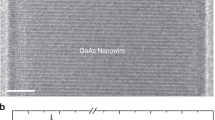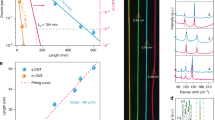Abstract
Semiconductor nanowires are key building blocks for the next generation of light-emitting diodes1, solar cells2 and batteries3. To fabricate functional nanowire-based devices on an industrial scale requires an efficient methodology that enables the mass production of nanowires with perfect crystallinity, reproducible and controlled dimensions and material composition, and low cost. So far there have been no reports of reliable methods that can satisfy all of these requirements. Here we show how aerotaxy, an aerosol-based growth method4, can be used to grow nanowires continuously with controlled nanoscale dimensions, a high degree of crystallinity and at a remarkable growth rate. In our aerotaxy approach, catalytic size-selected Au aerosol particles induce nucleation and growth of GaAs nanowires with a growth rate of about 1 micrometre per second, which is 20 to 1,000 times higher than previously reported for traditional, substrate-based growth of nanowires made of group III–V materials5,6,7. We demonstrate that the method allows sensitive and reproducible control of the nanowire dimensions and shape—and, thus, controlled optical and electronic properties—through the variation of growth temperature, time and Au particle size. Photoluminescence measurements reveal that even as-grown nanowires have good optical properties and excellent spectral uniformity. Detailed transmission electron microscopy investigations show that our aerotaxy-grown nanowires form along one of the four equivalent 〈111〉B crystallographic directions in the zincblende unit cell, which is also the preferred growth direction for III–V nanowires seeded by Au particles on a single-crystal substrate. The reported continuous and potentially high-throughput method can be expected substantially to reduce the cost of producing high-quality nanowires and may enable the low-cost fabrication of nanowire-based devices on an industrial scale.
This is a preview of subscription content, access via your institution
Access options
Subscribe to this journal
Receive 51 print issues and online access
$199.00 per year
only $3.90 per issue
Buy this article
- Purchase on Springer Link
- Instant access to full article PDF
Prices may be subject to local taxes which are calculated during checkout




Similar content being viewed by others
References
Qian, F., Gradečak, S., Li, Y., Wen, C.-Y. & Lieber, C. M. Core/multishell nanowire heterostructures as multicolor, high-efficiency light-emitting diodes. Nano Lett. 5, 2287–2291 (2005)
Borgström, M. T. et al. Nanowires with promise for photovoltaics. IEEE J. Sel. Top. Quantum Electron. 17, 1050–1061 (2011)
Chan, C. K. et al. High-performance lithium battery anodes using silicon nanowires. Nature Nanotechnol 3, 31–35 (2008)
Deppert, K. & Samuelson, L. Self-limiting transformation of monodisperse Ga droplets into GaAs nanocrystals. Appl. Phys. Lett. 68, 1409–1411 (1996)
Joyce, H. J. et al. Unexpected benefits of rapid growth rate for III−V nanowires. Nano Lett. 9, 695–701 (2009)
Borgström, M. T., Immink, G., Ketelaars, B., Algra, R. & Bakkers, E. P. A. M. Synergetic nanowire growth. Nature Nanotechnol. 2, 541–544 (2007)
Ramdani, M. R. et al. Fast growth synthesis of GaAs nanowires with exceptional length. Nano Lett. 10, 1836–1841 (2010)
Yazawa, M., Koguchi, M., Muto, A., Ozawa, M. & Hiruma, K. Effect of one monolayer of surface gold atoms on the epitaxial growth of InAs nanowhiskers. Appl. Phys. Lett. 61, 2051–2053 (1992)
Haraguchi, K., Katsuyama, T. & Hiruma, K. Polarization dependence of light emitted from GaAs p-n junctions in quantum wire crystals. J. Appl. Phys. 75, 4220–4225 (1994)
Björk, M. T. et al. One-dimensional steeplechase for electrons realized. Nano Lett. 2, 87–89 (2002)
Holmes, J. D., Johnston, K. P., Doty, R. C. & Korgel, B. A. Control of thickness and orientation of solution-grown silicon nanowires. Science 287, 1471–1473 (2000)
Wang, F. et al. Solution−liquid−solid growth of semiconductor nanowires. Inorg. Chem. 45, 7511–7521 (2006)
Duan, X. & Lieber, C. M. General synthesis of compound semiconductor nanowires. Adv. Mater. 12, 298–302 (2000)
Karlsson, L., Deppert, K. & Malm, J.-O. Size determination of Au aerosol nanoparticles by off-line TEM/STEM observations. J. Nanopart. Res. 8, 971–980 (2006)
Gudiksen, M. S., Wang, J. & Lieber, C. M. Size-dependent photoluminescence from single indium phosphide nanowires. J. Phys. Chem. B 106, 4036–4039 (2002)
Ford, A. C. et al. Diameter-dependent electron mobility of InAs nanowires. Nano Lett. 9, 360–365 (2009)
Magnusson, M. H., Deppert, K., Malm, J.-O., Bovin, J.-O. & Samuelson, L. Size-selected gold nanoparticles by aerosol technology. Nanostruct. Mater. 12, 45–48 (1999)
Kim, S. H. & Zachariah, M. R. Gas-phase growth of diameter-controlled carbon nanotubes. Mater. Lett. 61, 2079–2083 (2007)
Wacaser, B. A. et al. Preferential interface nucleation: an expansion of the VLS growth mechanism for nanowires. Adv. Mater. 21, 153–165 (2009)
Soci, C., Bao, X.-Y., Aplin, D. P. R. & Wang, D. A systematic study on the growth of GaAs nanowires by metal−organic chemical vapor deposition. Nano Lett. 8, 4275–4282 (2008)
Borgström, M., Deppert, K., Samuelson, L. & Seifert, W. Size- and shape-controlled GaAs nano-whiskers grown by MOVPE: a growth study. J. Cryst. Growth 260, 18–22 (2004)
Caroff, P., Bolinsson, J. & Johansson, J. Crystal phases in III–V nanowires: from random toward engineered polytypism. IEEE J. Sel. Top. Quantum Electron. 17, 829–846 (2011)
Bogardus, E. H. & Bebb, H. B. Bound-exciton, free-exciton, band-acceptor, donor-acceptor, and auger recombination in GaAs. Phys. Rev. 176, 993–1002 (1968)
Morral, A. F. Gold-free GaAs nanowire synthesis and optical properties. IEEE J. Sel. Top. Quantum Electron. 17, 819–828 (2011)
Heiss, M. et al. Direct correlation of crystal structure and optical properties in wurtzite/zinc-blende GaAs nanowire heterostructures. Phys. Rev. B 83, 045303 (2011)
Dong, A., Yu, H., Wang, F. & Buhro, W. E. Colloidal GaAs quantum wires: solution−liquid−solid synthesis and quantum-confinement studies. J. Am. Chem. Soc. 130, 5954–5961 (2008)
Duan, X., Wang, J. & Lieber, C. M. Synthesis and optical properties of gallium arsenide nanowires. Appl. Phys. Lett. 76, 1116–1118 (2000)
Moewe, M., Chuang, L. C., Crankshaw, S., Chase, C. & Chang-Hasnain, C. Atomically sharp catalyst-free wurtzite GaAs/AlGaAs nanoneedles grown on silicon. Appl. Phys. Lett. 93, 023116 (2008)
Freer, E. M., Grachev, O., Duan, X., Martin, S. & Stumbo, D. P. High-yield self-limiting single-nanowire assembly with dielectrophoresis. Nature Nanotechnol. 5, 525–530 (2010)
Huang, Y., Duan, X., Wei, Q. & Lieber, C. M. Directed assembly of one-dimensional nanostructures into functional networks. Science 291, 630–633 (2001)
Dresselhaus, M. S. et al. New directions for low-dimensional thermoelectric materials. Adv. Mater. 19, 1043–1053 (2007)
Boukai, A. I. et al. Silicon nanowires as efficient thermoelectric materials. Nature 451, 168–171 (2008)
Taftø, J. & Spence, J. C. H. A simple method for the determination of structure-factor phase relationships and crystal polarity using electron diffraction. J. Appl. Crystallogr. 15, 60–64 (1982)
Acknowledgements
We thank M. Borgström for discussions on the nanowire growth, B. Meuller for technical assistance with the growth setup, D. Csontos for reviewing our manuscript before submission and B. Pedersen for supporting this project by making the infrastructure of Sol Voltaics AB available. We acknowledge G. Alcott and E. Nilsson for sharing their preliminary results on doping. This project is performed within the Nanometer Structure Consortium at Lund University (nmC@LU) and with financial support from the Swedish Research Council, the Swedish Foundation for Strategic Research, the Knut and Alice Wallenberg Foundation and VINNOVA.
Author information
Authors and Affiliations
Contributions
M.H., M.H.M., K.D. and L.S. designed the growth experiments. M.H. and M.H.M. performed the growth experiments. M.H., M.H.M., D.L. and M.E. performed the characterization and data analysis. K.D., L.R.W. and L.S. supervised the project. M.H. and L.S. wrote the main part of the paper. All authors reviewed and commented on the manuscript.
Corresponding author
Ethics declarations
Competing interests
The authors declare no competing financial interests.
Supplementary information
Supplementary Information
This file contains Supplementary Text and Data, Supplementary Table 1 and Supplementary Figures 1-7. (PDF 1426 kb)
Rights and permissions
About this article
Cite this article
Heurlin, M., Magnusson, M., Lindgren, D. et al. Continuous gas-phase synthesis of nanowires with tunable properties. Nature 492, 90–94 (2012). https://doi.org/10.1038/nature11652
Received:
Accepted:
Published:
Issue Date:
DOI: https://doi.org/10.1038/nature11652
This article is cited by
-
Pulmonary toxicity and translocation of gallium phosphide nanowires to secondary organs following pulmonary exposure in mice
Journal of Nanobiotechnology (2023)
-
Ex ante life cycle assessment of GaAs/Si nanowire–based tandem solar cells: a benchmark for industrialization
The International Journal of Life Cycle Assessment (2020)
-
In situ observation of synthesized nanoparticles in ultra-dilute aerosols via X-ray scattering
Nano Research (2019)
-
InP/GaInP nanowire tunnel diodes
Nano Research (2018)
-
Molecular dynamics and thermodynamic simulations of segregation phenomena in binary metal nanoparticles
Journal of Thermal Analysis and Calorimetry (2018)
Comments
By submitting a comment you agree to abide by our Terms and Community Guidelines. If you find something abusive or that does not comply with our terms or guidelines please flag it as inappropriate.



